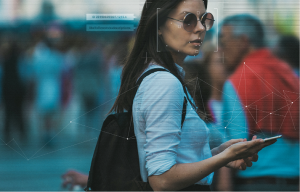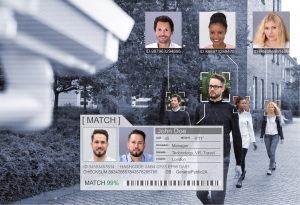How to escape facial recognition

Milon Gupta
Eurescom
gupta(at)eurescom.eu
Facial recognition is becoming ubiquitous. That is great news for marketers, policemen and dictators. Privacy-conscious citizens, however, are not amused. They do not relish the prospect of living in a surveillance society, where authorities and tech giants can monitor every step they make. Are there ways to defy surveillance and escape facial recognition? A few innovators have taken up the challenge.

© Adobe Stock
The road to ubiquitous surveillance
Over the past decade, dozens of databases of people’s faces have been compiled globally by companies and researchers. Many of these images are shared around the world, thus spreading the use and effectiveness of facial recognition technology. The databases are built on images from social networks, photo websites, dating services, and cameras placed in restaurants and on campuses.
Facial recognition is already commonplace in China: police scan public spaces for suspects, consumers pay their shopping with their faces, and taxes are paid by face as well. Chinese unicorn start-ups like Megvii, SenseTime, CloudWalk, and Yitu are providing solutions, which contribute to the Chinese government’s goal of becoming global leader in Artificial Intelligence. The solutions are used by the Chinese government to establish complete surveillance of all its citizens.
Although China may be most advanced in the size and scope of using facial recognition, US tech giants like Google, Facebook and Microsoft are pushing the deployment of this technology as well – and so is the US government. US Immigration and Customs Enforcement officials have employed facial recognition technology to scan motorists’ photos to identify undocumented immigrants. And the FBI has used such systems for more than a decade to compare driver’s licenses and visa photos with the faces of suspected criminals, according to a Government Accountability Office report.
Many other countries are quickly adopting facial recognition technology to identify their citizens. In Europe, France is to become the first European country to use facial recognition technology for identifying citizens. The French government is planning to incorporate facial recognition technology into a mandatory digital identity for its citizens.
In November France was to roll out an ID programme called Alicem, an acronym for “certified online authentification on mobile”. The Alicem app reads the chip on an electronic passport and checks its biometric photo with the mobile phone user via facial recognition to validate the identity. Once confirmed, the user can access a host of public services without further checks.
France’s data regulator, CNIL, has warned that the programme breaches the EU’s legal requirement of consent, because it provides no alternatives to facial recognition to access certain services. In addition, there are concerns over data security, as an allegedly secure French government messaging app was hacked earlier in 2019. Sooner or later, it will be hard to find a spot on Earth, where your face is not recognised. More importantly, our faces will be increasingly used as identifiers to withdraw money or pass border controls. This increases the incentives for hackers to steal your digital face and get access to your money and more.
Blocking facial recognition
Are we completely defenceless against facial recognition? An Israeli start-up says ‘No’. The startup called D-ID claims to have developed a new solution which blocks facial recognition. Current solutions like eyeglasses that reflect light to jam cameras or camouflaging your face through make-up and fancy headgear are of limited use for not being recognised. Thus, D-ID has gone in a different direction: they replace human faces with computer-generated faces. The modifications are just enough to escape detection by facial recognition algorithms. If you put the original photo and the manipulated image side by side, the changes are noticeable, but on its own the altered picture appears normal. Their solution, called ‘Smart Anonymization’ can be used for videos and still images.
‘Smart Anonymization’ removes facial images without processing or profiling the subject. It then replaces the images with AI-generated, photorealistic faces of non-existent people. D-ID claims that these anonymised faces make the technology far superior compared to legacy solutions which rely on blurring or pixelation. The anonymized faces preserve key non-identifying attributes of the original face including age, gender, expression, gaze direction and more. According to D-ID, this allows for analytics to be performed while respecting privacy laws and regulations.

© Adobe Stock
Alternatives and open questions
As elegant as D-ID’s solution appears, it is not a panacea for escaping facial recognition. First of all, many people already have unaltered photos of themselves on the Web, which have already been stored and processed in the databases of tech giants and authorities. Second, it is not unlikely that AI-powered facial recognition systems will further advance and either link anonymized faces to real faces in the database or at least mark the manipulated photos as such and deny access.
Recently, a woman from the Chinese city of Wenzhou found out that after plastic surgery, her access to all kinds of services that require facial recognition was blocked. Among others, access to payment services and online shops was denied, because the systems could not identify her anymore. Her doctor recommended that she should just register again on the central identification system. I have no information how that worked out, but at least it meant a lot of hassle for the woman.
What alternatives are there? Some designers have been very imaginative in designing anti-surveillance hijabs, fashionable camouflage, photo-realistic, 3D-printed face masks, and seemingly random patterns printed on shirts to dazzle computer algorithms.
Outside of China, you might get away with such fancy trickery. However, the moment you go through security at an airport, your camouflage will only get you in trouble – instead of an AI system, a flesh-and-blood police officer will identify you.
Does this mean there is no escape from facial recognition and a surveillance society like in China? Not necessarily. Even if technical means may be too limited to fool facial recognition systems, democratic societies offer more potent means to stop tech giants and authorities from spying on us – public debate and legislation. It may take more time than donning a face mask, but it could be more effective in the long run.
Further information: Website of Israeli start-up D-ID – https://www.deidentification.co